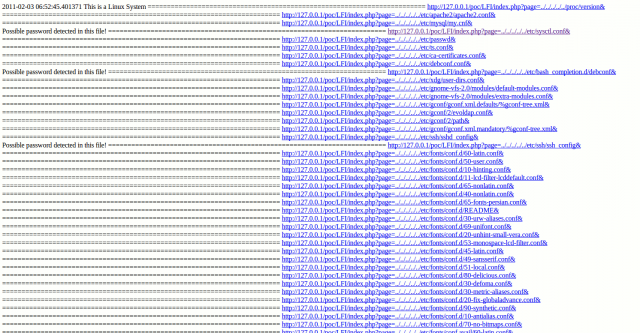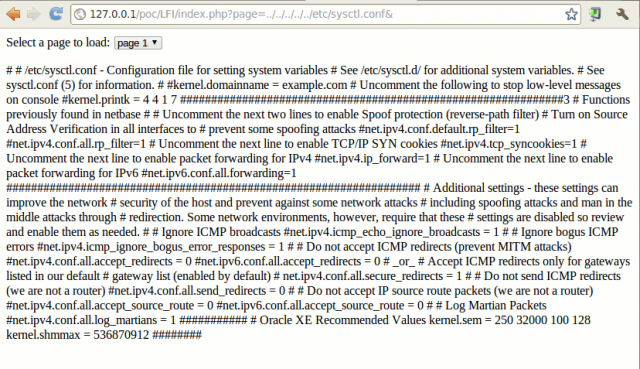Features
- Signature-free
- Session Splicing
- User-Agent and Log injection
- Arithmetic Test
Usage
perl lfi_autopwn.pl -h www.vuln.tld -u "/vuln.ext?page=main&foo=bar" -i page
This script will attempt to gain code execution on sites vulnerable to local
file inclusion via an httpd error log or by modifying the user-agent and including a file containing environment variables. The
php
code execution test is performed using an arithmetic challenge, and the
script uses system() as its php execution function. The fact that
every part of this process is randomized including the math challenge
prevents signature based detection while LibWhisker provides
IDS Evasion.
Notice:
It is possible that this script will not work on your intended target
but tests positive for php execution. In that case, changing your bash
command execution function from system to one of many others is most
likely to yield the desired results.
Protip: Make sure you've saved httpdlogs.conf to the same directory as lfi_autopwn.pl.
httpdlogs.conf

|
The httpdlogs.conf file dictates filenames for possible error log locations.
|
If you know any filenames that aren't listed
here, feel free to add them to your local copy. Files are simply
separated by newline.
- ./err.log
- ./error_log
- ./error.log
- /etc/httpd/conf/logs/error_log
- /etc/httpd/logs/error_log
- /home/php5/logs/error_log
- ../log/error_log
- ../log/error.log
- ../logs/error_log
- ../logs/error.log
- /proc/self/fd/2
- /usr/local/apache2/log/error_log
- /usr/local/apache2/logs/error_log
- /usr/local/apache2/logs/error.log
- /usr/local/apache/error.log
- /usr/local/apache/log/error_log
- /usr/local/apache/logs/error_log
- /usr/local/apachessl/logs/dummy-host.example.com-error_log
- /usr/local/apachessl/logs/error_log
- /usr/local/httpd/log/error_log
- /usr/local/httpd/logs/error_log
- /usr/local/php/log/error_log
- /var/log/apache2/error_log
- /var/log/apache2/error.log
- /var/log/apache/error_log
- /var/log/httpd-error.log
- /var/log/httpd/error_log
- /var/log/nginx/error.log
- /var/log/php-fcgi/error_log
- /var/log/php-fpm/err.log
Other Execution/Interesting PHP Functions
passthru, leak, link, shell_exec, exec, show_source, fpaththru,
virtual, posix_ctermid, posix_getcwd, posix_getegid, posix_geteuid,
posix_getgid, posix_getgrgid, posix_getgrnam, posix_getgroups,
posix_getlogin, posix_getpgid, posix_getpgrp, posix_getpid, posix,
_getppid, posix_getpwnam, posix_getpwuid, posix_getrlimit, posix_getsid,
posix_getuid, posix_isatty, posix_kill, posix_mkfifo, posix_setegid,
posix_seteuid, posix_setgid, posix_setpgid, posix_setsid, posix_setuid,
posix_times, posix_ttyname, posix_uname, proc_open, proc_close,
proc_get_status, proc_nice, proc_terminate, phpinfo => php_uname,
getmyuid, getmypid, passthru, leak, listen, diskfreespace, tmpfile,
link, ignore_user_abord, shell_exec, dl, set_time_limit, exec, system,
highlight_file, source, show_source, fpaththru, virtual, posix_ctermid,
posix_getcwd, posix_getegid, posix_geteuid, posix_getgid,
posix_getgrgid, posix_getgrnam, posix_getgroups, posix_getlogin,
posix_getpgid, posix_getpgrp, posix_getpid, posix, _getppid,
posix_getpwnam, posix_getpwuid, posix_getrlimit, posix_getsid,
posix_getuid, posix_isatty, posix_kill, posix_mkfifo, posix_setegid,
posix_seteuid, posix_setgid, posix_setpgid, posix_setsid, posix_setuid,
posix_times, posix_ttyname, posix_uname, proc_open, proc_close,
proc_get_status, proc_nice, proc_terminate, phpinfo













![[Image: puuwl.png]](http://u1307.hizliresim.com/1c/3/puuwl.png)
![[Image: puvcz.png]](http://j1307.hizliresim.com/1c/3/puvcz.png)







